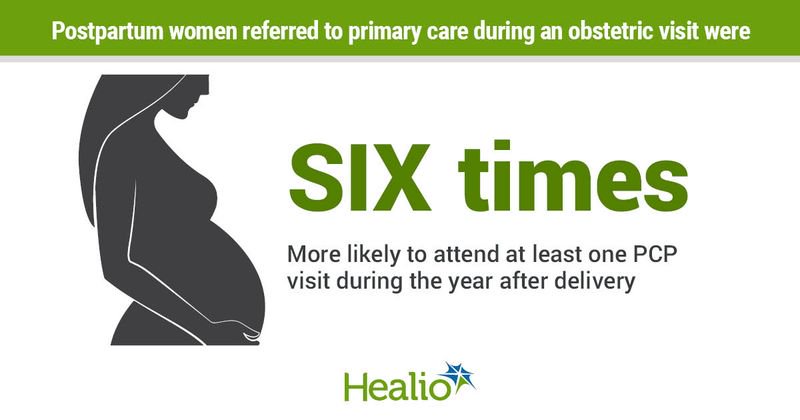Referral program boosts postpartum visits to primary care during year after delivery
Key takeaways:
- Postpartum women referred from obstetrics to primary care via a pilot program were more likely to attend a PCP visit.
- PCP visit attendance was lowest among Black and Hispanic women and those receiving Medicaid.
Women with gestational diabetes or hypertension referred from obstetrics to a primary care provider after delivery were six times more likely to attend a visit with a PCP in the first year postpartum, data show.
In addition, they were twice as likely to complete cholesterol and HbA1c screenings.

Many women do not follow up with a PCP during the first year after delivery; however, postpartum programs that can be inexpensively and sustainably integrated into existing health care settings could potentially improve postpartum care and CV health monitoring, particularly for underserved women, according to Natalie A. Cameron, MD, MPH, internal medicine specialist and instructor at Northwestern University Feinberg School of Medicine. Researchers at Northwestern created and piloted an enhanced postpartum primary care referral program for women with gestational diabetes or a hypertensive disorder of pregnancy, leveraging existing health care resources to encourage follow-up with primary care.
“Women are busy, have a new baby at home and have little time to go to the doctor themselves,” Cameron told Healio. “At the system level, not every hospital has a standard way of helping these patients navigate the health care system and people may be confused about who their doctor is after pregnancy. In addition, some women lose their insurance during that first year postpartum, depending on their state of residence.”

A ‘nudge’ to see a PCP after delivery
For the pilot program, researchers analyzed data from 1,879 eligible patients who received perinatal care at a large urban academic medical center, were diagnosed with gestational diabetes or a hypertensive disorder of pregnancy and did not have a PCP. Resident, faculty and advanced practitioners referred 129 of those patients to a PCP during antenatal, delivery-related or postpartum visits. A dedicated scheduler then contacted patients to schedule an appointment with a women’s health-focused resident or faculty PCP in the first year postpartum.
“During either the prenatal visit, the delivery hospitalization or the postpartum visit, women received a referral to primary care while at their obstetrician’s office,” Cameron said during an interview. “Women would then receive a phone call from the scheduler in primary care to make the appointment. Once they had that appointment within the first year, it was up to them to attend the appointment; they received standard care after that.”
Researchers then compared the percent of patients who attended a postpartum PCP visit, who had an HbA1c and cholesterol panel checked within the first 13 months postpartum among those who were referred to the program vs. those who were not referred. The findings were published in the Journal of Women’s Health.
Among the 129 women referred, the mean age at delivery was 33 years; 30.2% had Medicaid during pregnancy; 34.9% were Black and 18.6% were Hispanic. More than half of women had a hypertensive disorder of pregnancy (51.8%); 31% had gestational diabetes and 10.9% had both conditions.
Within the first 13 months after delivery, 48.1% of women referred to the program attended a PCP visit compared with 13.9% of women not referred; odds were six times higher after adjusting for age, parity, insurance type and referral indication (95% CI, 4-9). Most PCP encounters took place in person.
Compared with nonreferred women, referred women were more likely to attend at least one PCP visit (aOR = 3.9; 95% CI, 2.5-6), have a cholesterol panel checked (aOR = 2.4; 95% CI, 1.6-3.9) and have an HbA1c screening (aOR = 2.5; 95% CI, 1.7-3.7). Among women who attended a PCP visit, those who were referred were more likely to do so within the first 3 months postpartum compared with those not referred (61.3% vs. 25.1%).
“Women who got that nudge — who received that phone call — were six times more likely to attend a primary care visit during the first year postpartum,” Cameron told Healio. “People who attended the visit were more likely to get their HbA1c and cholesterol checked as well. The big picture; however, is that, despite the enhanced referral program, only about 50% of people came back. The program was a great first step, but it still is not enough.”
More work needed for underserved women
In subgroup analyses, PCP visit attendance, cholesterol and HbA1c monitoring were higher among those referred to the program than among those not referred in each demographic and clinical subgroup; however, PCP visit attendance was lowest among individuals who self-identified as Hispanic or Black or who were enrolled in Medicaid, regardless of referral status.
“A little bit of counseling and a phone call does help quite a bit,” Cameron told Healio. “But as providers and researchers, we need to do better. We need to fully explore the barriers to healthcare access among historically underrepresented communities and design programs that address these needs. Utilization of telehealth, home visiting programs, community health workers, and transitional care clinics have shown some promise, but we need more research to fully explore the efficacy of these programs in promoting health equity.”
The pilot program data follows research, also conducted by Cameron and colleagues, which show postpartum CV counseling rates remain low after adverse pregnancy outcomes. As Healio previously reported, data show no meaningful differences or changes in the prevalence of postpartum CV health counseling among people with CVD risk factors from 2016 to 2020, despite increasing awareness of the importance of CV health promotion.
For more information:
Natalie A. Cameron, MD, MPH, can be reached at natalie.cameron@northwestern.edu; X (Twitter): @NatCamMD.

